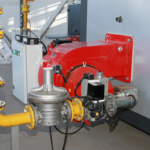Monitoring Responsibilities
Air Emission Sources
Reporting Compliance
Funding
Public Participation
Title V Operational Air Permits
In Lane County, the Lane Regional Air Protection Agency is responsible for issuing air permits to commercial and industrial operations with emissions above certain thresholds. LRAPA’s air permits have operational requirements that follow Federal, State, and Local regulations designed to minimize emissions from businesses.
There are approximately 300 commercial and industrial operations in Lane County with an air permit issued by LRAPA. LRAPA’s permits are categorized into different grouping based on the complexity of the permit. The most complex permits are federal Title V operational air permits.
This page is dedicated to the Title V program. To learn more about the other types of air permits LRAPA issues, visit our ACDP informational page.

Title V Operating Permits
Title V of the 1990 Federal Clean Air Act requires each state to develop a comprehensive operating permit program for major industrial sources of air pollution. The program clarifies the environmental obligations of a business by organizing, in 1 document, all of a business’ air pollution control requirements.
Title V operating permits are used to regulate major sources of air contaminant emissions. A “major source” has actual or potential emissions above 100 tons/year for any criteria pollutant; over 10 tons/year for a single “Hazardous Air Pollutant” (HAPs); and/or 25 tons/year for any combination of HAP.
The Title V Operating Permit Program does not require any tighter emissions standards; it does, however, place a greater responsibility on the business for monitoring, reporting and certifying compliance with the conditions of the permit.
Monitoring Responsibilities
 The Oregon Title V Operating Permit Program places greater responsibilities on the source of air pollution. When a business applies for a permit within Lane County, it is required to supply the Lane Regional Air Protection Agency (LRAPA) with all the information necessary to draft a permit. After the permit is issued, the permitted source has a responsibility to monitor its compliance with requirements of the permit and to keep detailed records and reports.
The Oregon Title V Operating Permit Program places greater responsibilities on the source of air pollution. When a business applies for a permit within Lane County, it is required to supply the Lane Regional Air Protection Agency (LRAPA) with all the information necessary to draft a permit. After the permit is issued, the permitted source has a responsibility to monitor its compliance with requirements of the permit and to keep detailed records and reports.
LRAPA’s role is to evaluate the information provided by the business, issue the permit and make periodic compliance determinations through inspections and review of reports and records and take enforcement action when appropriate.
What Is In a Title V Operating Permit?
The Title V Operating Permit organizes in a single document all the air requirements which apply to the permit holder. The operating permit follows the same structure and format as an Air Contaminant Discharge Permit (ACDP) but contains greater detail. The operating permit begins with a list of permitted activities and describes all emission units and pollution control devices at the facility. Then the permit lists all the emission limits and standards which apply to the facility. The next section of the permit describes methods of monitoring and record keeping being used by the permit holder to determine compliance with all applicable requirements.
Finally, the permit describes the methods to be used by the permit holder for reporting and certifying compliance to LRAPA. In contrast, LRAPA’s ACDPs contain less detail in the identification of emission units. The ACDPs also typically do not list all applicable requirements, require less monitoring, and have less detailed record keeping and reporting requirements.
Reporting Compliance with Conditions
Under the Title V Operating Permit Program, a permit holder must report on compliance with conditions of its permit at least every six months. At that time, a responsible official must either certify compliance or inform LRAPA of noncompliance and submit a schedule to bring the operation into compliance. If certifications are falsified, federal and state law provide for both civil and criminal enforcement actions. Violations found to be done knowingly are a felony, with potential for imprisonment for up to five years and fines up to $250,000.
Public Participation
Under the Title V Operating Permit Program, there are increased opportunities for the public to take part in determining how the law will be carried out. All new permits, renewals, and significant permit modifications must have a public notice period during which citizens can comment on the permit and request a public hearing. Issues that are not resolved with LRAPA can be appealed to EPA. Neighboring states and EPA also have more opportunity to comment on permit content.
Added Enforcement Powers to EPA
The 1990 Clean Air Act provides additional enforcement powers to the U.S. Environmental Protection Agency (EPA), DEQ, and LRAPA. In the past, EPA had to go to court to penalize a company for violations. Now the EPA can issue administrative penalty orders of up to $25,000 per violation. The EPA also has authority to fine violators up to $5000 for minor violations observed in the field. LRAPA continues to use its authority to issue administrative penalties and adopt enforcement provisions where the knowing endangerment from the release of air toxics can carry imprisonment of up to 15 years and fines up to $1 million. Citizen lawsuit provisions are also expanded in the act.
Air Toxics/Hazardous Air Pollutants (HAPs) Program
The Clean Air Act requires that states use the Title V Operating Permit System to administer the Air Toxics Program. Although the majority of Title V Operating Permits do not contain enforceable limits on specific hazardous air pollutants, most of the hazardous air pollutants are regulated as particulate or VOCs. The review report of the permit will usually contain rough estimates of other hazardous air emissions. These estimates in the review report are for information purposes only and are not specified as enforceable limits. As techniques for estimating hazardous air pollutant emissions improve, some of these estimates may increase while others decrease.
Funding
The entire cost of the Title V Operating Permit Program is funded through emission fees, base fees and user fees from the regulated businesses. The emission fees will result in the industries with the highest emissions paying the majority of the cost of the program.
Air Emission Sources
As defined in the program, a major source of air emissions has the potential to emit 100 tons of any criteria pollutant. Or, for emitters of hazardous air pollutants, a major source has the potential to emit 10 tons of any single hazardous air pollutant or 25 tons of any combination of hazardous air pollutants. A major source can choose to limit its potential to emit through federally enforceable physical or operational restrictions on the facility and can remain in the ACDP program as what is known as a synthetic minor source. Approximately 14 sources are currently permitted under the LRAPA Title V Operating Permit Program.
Sharply Reducing “Routine” Emissions
 EPA has set standards requiring companies to sharply reduce “routine” emissions of hazardous air pollutants. EPA will do so by setting performance standards based on the best demonstrated controls and practices for each regulated industry, termed Maximum Achievable Control Technology (MACT). Should EPA miss an established deadline for setting a MACT standard, the states must issue these standards.
EPA has set standards requiring companies to sharply reduce “routine” emissions of hazardous air pollutants. EPA will do so by setting performance standards based on the best demonstrated controls and practices for each regulated industry, termed Maximum Achievable Control Technology (MACT). Should EPA miss an established deadline for setting a MACT standard, the states must issue these standards.
Particularly Hazardous Substances
EPA has also established a list of substances that are particularly hazardous when inadvertently released into the air by an unanticipated or uncontrolled event. Title V Operating Permit Applications require the business to indicate the range of the facility’s annual usage of these chemicals. Facilities that use more than established quantities of these substances will be required to prepare risk management plans and comply with accidental release prevention regulations.

